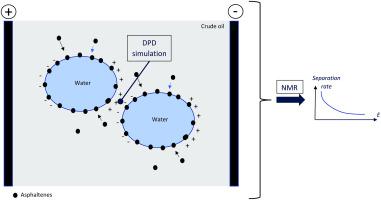Advances in Colloid and Interface Science ( IF 15.9 ) Pub Date : 2021-05-30 , DOI: 10.1016/j.cis.2021.102455 Johan Sjöblom 1 , Sameer Mhatre 2 , Sébastien Simon 1 , Roar Skartlien 3 , Geir Sørland 4

|
Water is co-produced with crude oils, generally in the form of water-in-crude oil emulsions. The oil and water phases need to be separated before export. Separation is performed in gravity separators with the addition of chemical demulsifiers and, sometimes, with the application of an electric field by using an electrocoalescer. The present article reviews several aspects of electrocoalescence by considering the effect of the electric field from the molecular to a macroscopic scale: the oil-water interface, single drop effects, two drop interactions, and finally emulsions at laboratory scales. Experimental results together with Dissipative Particle Dynamics (DPD) simulation results are presented.
The review begins with water-oil interface under an electric field and followed by single drop electrohydrodynamics. The electric field is shown to influence the adsorption of crude oil indigenous surface-active components (asphaltenes) due to the electrohydrodynamic (EHD) flows. The interactions between two droplets in the presence of electric field and the factors governing the drop-drop coalescence are discussed in detail.
DPD simulations help to elucidate thin film breakup during (electro)-coalescence of two water droplets, where the oil film has drained out to nanometer thickness. The film is comprised of surfactant and demulsifier molecules, and the simulations capture the pores formation in the film when a DC field is applied. The results demonstrate influence of the molecular structure of the surfactant and demulsifier, and their interactions.
The subsequent section describes experimental techniques to assess the resolution of crude oil emulsions at the laboratory scale. The focus is on low-field Nuclear Magnetic Resonance (LF-NMR) which allows a determination of various emulsion features such as the droplet size distribution (DSD) and the brine profile (variation of the concentration of water with the height of the emulsion sample) and their evolution with time. Application of the technique in emulsion treatment involving chemical demulsifiers and electric field is presented. The review concludes with description of commercial industrial electrocoalecers such as the Vessel Internal Electrostatic Coalescer (VIEC) and the Compact Electrostatic Coalescer (CEC).
中文翻译:

外电场中的乳液
水与原油共同生产,通常以原油包水乳液的形式出现。出口前需要将油相和水相分离。分离是在重力分离器中通过添加化学破乳剂进行的,有时还通过使用电聚结器施加电场。本文通过考虑电场从分子到宏观尺度的影响来回顾电聚结的几个方面:油水界面、单滴效应、两滴相互作用,最后是实验室规模的乳液。实验结果与耗散粒子动力学 (DPD) 模拟结果一起呈现。
审查从电场下的水油界面开始,然后是单滴电流体动力学。由于电流体动力学 (EHD) 流动,电场显示出影响原油固有表面活性成分(沥青质)的吸附。详细讨论了存在电场时两个液滴之间的相互作用以及控制液滴聚结的因素。
DPD 模拟有助于阐明两个水滴(电)聚结期间的薄膜破裂,其中油膜已排出至纳米厚度。薄膜由表面活性剂和破乳剂分子组成,当施加直流电场时,模拟捕获薄膜中的孔隙形成。结果证明了表面活性剂和破乳剂的分子结构及其相互作用的影响。
随后的部分描述了在实验室规模评估原油乳液分辨率的实验技术。重点是低场核磁共振 (LF-NMR),它允许确定各种乳液特征,例如液滴尺寸分布 (DSD) 和盐水分布(水浓度随乳液样品高度的变化) ) 及其随时间的演变。介绍了该技术在涉及化学破乳剂和电场的乳液处理中的应用。该评论最后描述了商业工业电聚结器,例如容器内部静电聚结器 (VIEC) 和紧凑型静电聚结器 (CEC)。











































 京公网安备 11010802027423号
京公网安备 11010802027423号